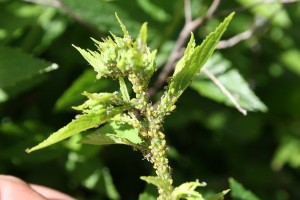— by Dr. Raymond Cloyd
The extreme heat we are experiencing throughout Kansas and the fact that plants are “stressed” due to a lack of moisture means you need to be on the look-out for the twospotted spider mite, Tetranychus urticae (Figures 1 and 2). Twospotted spider mite is a warm-weather mite because, in general, populations are active from late spring through early fall. Summer temperatures allow twospotted spider mites to reproduce rapidly, which helps them to overwhelm natural enemy populations. This article discusses the plant protection strategies that homeowners and professionals can implement in order to alleviate or avoid problems with twospotted spider mite populations.
Fig 1: Twospotted spider mite adults and eggs (spherical shape objects).
Fig 2: Twospotted spider mite feeding damage.
Twospotted spider mite management involves maintaining plant health, implementing sanitation practices, and/or using pesticides with miticidal activity (miticides/acaricides). First of all, avoid exposing plants to any type of “stress” by maintaining proper watering, fertilizer, and mulching practices so as to reduce potential problems with twospotted spider mite populations. For example, inadequate moisture or overfertilizing plants, particularly with nitrogen-based fertilizers, can enhance development and reproduction of twospotted spider mites. Also, be sure to monitor for twospotted spider mite populations regularly by shaking branches or twigs onto a white sheet of paper, and looking for the mites crawling around. You can crush the mites on the white sheet of paper to determine if they are a pest or not. For instance, plant-feeding spider mites typically leave a green streak when crushed whereas predatory mites leave a red streak. A quick method of dealing with twospotted spider mite populations is applying a forceful water spray throughout the plant canopy at least twice per week during the season. Forceful water sprays will dislodge eggs and the motile life stages (larvae, nymphs, and adults). Be sure to direct forceful water sprays toward the leaf undersides where all life stages (eggs, nymphs, larvae, and adults) of the twospotted spider mite are located. The removal of plant debris and weeds eliminates alternative hosts and overwintering sites.
There are many pesticides with miticidal activity available to professionals for suppression of twospotted spider mite populations outdoors, including: abamectin (Avid), acequinocyl (Shuttle), bifenazate (Floramite), etoxazole (TetraSan), hexythiazox (Hexygon), potassium salts of fatty acids (M-Pede), and horticultural oils (petroleum, mineral, or neem-based). Homeowners do not have many options in regards to miticides. The only “true miticide” still available is hexakis or fenbutatin-oxide, however, this active ingredient cannot be purchased by itself as the active ingredient is usually formulated with acephate (Orthene). Always read the label and apply miticides before twospotted spider mite populations are extensive and causing aesthetic damage. Furthermore, be sure to rotate miticides with different modes of action in order to avoid twospotted spider mite populations developing resistance. If possible, try to target “hot spots” or localized infestations of twospotted spider mites, which will reduce the potential for resistance developing. Be sure to thoroughly cover all plant parts with spray applications; especially when using pesticides with contact activity. Some miticides such as abamectin (Avid) and etoxazole (TetraSan) have translaminar activity, which means that the material penetrates into leaf tissues and forms a reservoir of active ingredient within the leaf. This provides residual activity even after spray residues have dried. Mites that feed on leaves will ingest a lethal concentration of the active ingredient and be killed.
It is important to note that many pesticides used to suppress other insect pests encountered on plants in landscapes and gardens may be harmful to the natural enemies of twospotted spider mite; consequently, resulting in an inadvertent increase in twospotted spider mite populations or secondary pest outbreaks.


